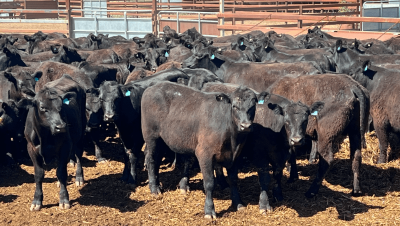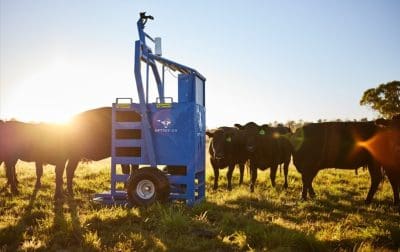THERE’S been little substantive change in feeder prices across eastern Australia as the grainfed industry gets back to work after the Easter/ANZAC Day break.
In Queensland, competitive supply chains are this week offering 375-380c/kg delivered Downs for paddock-purchased flatback heavy feeders, and Angus in a wide range from 405c to 435c/kg, depending on each individual operators’ current procurement position. There’s been little movement in these rates since before Easter.

With the exception of the Channels, northern grazing country is now drying out following earlier rain to the extent that logistics is now much less of a problem for feedlots and processors. There is little residual impact left since earlier rain disruptions, that saw cattle backing up in feedlots for a couple of weeks due to processing challenges.
Prospects of early frosts will come into calculations for some producers considering their turnoff options over the next month or so. Large lotfeeders on the Darling Downs and in Northern NSW are anticipating feeder cattle supply to be ‘solid to strong’ through May, barring more unexpected weather.
The risk of heavy cattle ‘blowing out the top’ (exceeding upper spec weight limits) has seen a few mobs walked-out to more loading points since Easter, Beef Central has been told.
In southern regions, quotes obtained this morning show Angus feeders delivered Southern Riverina region at 420-440c/kg, with some of the higher prices up 10c on the week before. Southern quotes for British cross were harder to pin down this week.
Rain in parts of NSW and Victoria over the weekend could slow southern feeder supply for a period, especially if there is decent follow-up. It’s looking increasingly likely that there will be some north-to-south flow of feeders later in the year, as the deficit of heavy flatback feeders in many southern regions really starts to show.
Given current and future export beef demand prospects, few, if any feedlots want to be looking at empty pens in the immediate future, adding to the supply challenge.
Grass ox option?
One question which has arisen since March-April rain is whether some young cattle originally destined to be sold as feeders will be retained by owners to utilise available feed, and be turned into grass ox.
The general feedback from supply chain managers was that if it occurred at all, the numbers would be only modest. The current healthy size of the national beef herd would also dilute any negative effect if a few more feeders are held back on grass, one large grainfed operator said.
“There’s less grass bullocks produced each year. Most people are geared-up in management programs to produce feeders now. There will be a percentage of cattle that get too heavy as feeders – no doubt – but I don’t see prospects for a large-scale shift into grassfed bullocks.”
“It’s talked-about every time there is a bit of surplus grass around, but you’d need to halve your numbers to grow out bullocks like this – and it only lasts for a year, at best,” he said.
Smaller mobs, but more frequent turnoff of feeders?
Some theories are emerging about what impact the late summer break in large parts of Queensland and NSW will have on the feeder market.
It’s widely recognised that feeders are likely to be heavier (on average) this year, especially later in the cycle due to recent weather and pasture/herbage growth.
One suggestion is that feeder turnoff will be a lot more segmented this year than normal.
 Automated in-field weighing systems like Optiweigh mean many cattle producers now have a much better handle on weightgain than they did in times past. Optiweigh recently delivered its one-thousandth weighing unit to a Queensland cattle operator.
Automated in-field weighing systems like Optiweigh mean many cattle producers now have a much better handle on weightgain than they did in times past. Optiweigh recently delivered its one-thousandth weighing unit to a Queensland cattle operator.
Most feeder steer grids published by large operators in eastern Australia seek steers in a range from 380-500kg (in some cases 480kg, and a couple 520kg) before overweight penalties apply. In one example where the upper limit is 500kg, feeder steers 500-519kg are discounted 20c/kg, while +520kg is back another 55c/kg.
Another grid with an upper limit of 480kg drops 20c/kg from 481-500kg, and another 10c for +500kg. So the deterrents are pretty strong.
While the number of feeders that arrive at large feedlot operators’ induction pens that are outside the sweet-spot might be surprising to some, one operator pointed out that for larger vendors, having a few ‘outliers’ was a small price to pay for getting the bulk of the mob at the upper end of the acceptable weight range.
“If you are pushing the weights – which quite a lot of larger vendors do, for obvious reasons – there will always be a few that blow out the top, otherwise they feel they are selling them too light,” one supply chain manager said.
For others, instead of selling 12 decks of feeders in one run, for example, they might elect this year to sell six decks of heavier steers now, and let the remainder at the lighter end add some further weight before being marketed. That strategy becomes difficult for some larger operators, however, where fixed costs like helicopter mustering make it prohibitive to return to the same mob twice.
“Many feeder steer vendors will be looking to add as much weight as possible at the lighter end, and for some, that’s easier to do by breaking larger mobs down into smaller units,” one large feeder steer buyer said this morning.
Saleyards
In the saleyards system, early sales this week indicate some weakness, with some cheaper black feeder weight steers available in Wagga this morning. See separate Wagga report today.
The NLRS feeder steer indicator, based on a seven day rolling average of sales in the appropriate weight range (all breed types) across 22 NLRS reported saleyards, currently sits at 385c/kg, up about 6c since just before Easter, and 14c higher than this time last month.

HAVE YOUR SAY